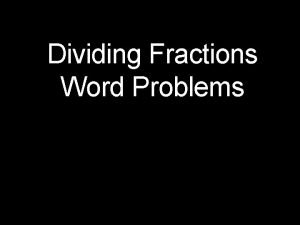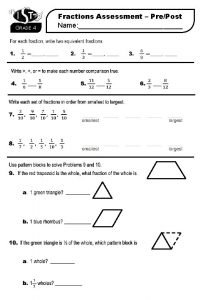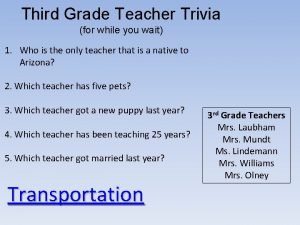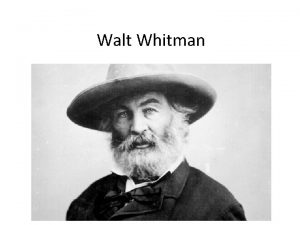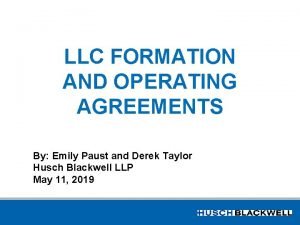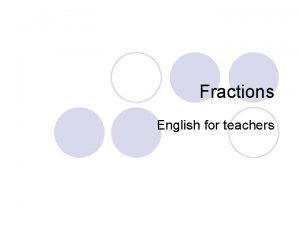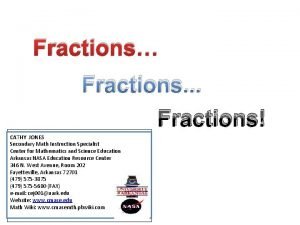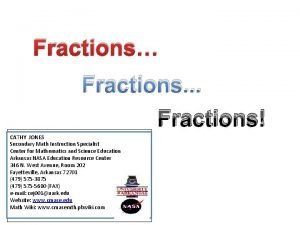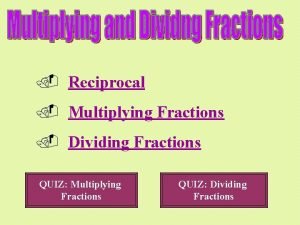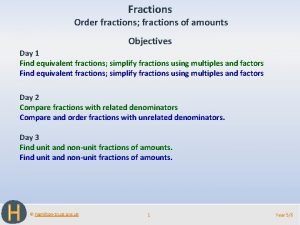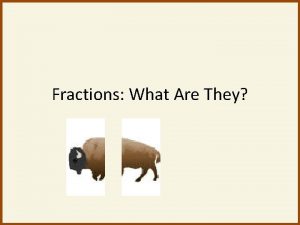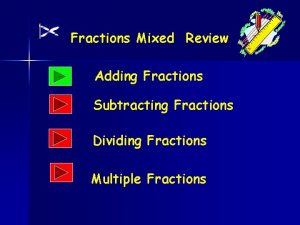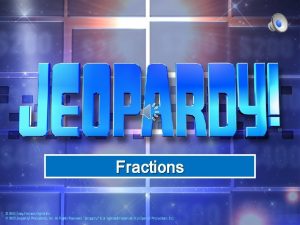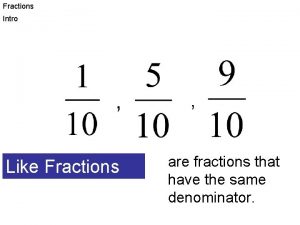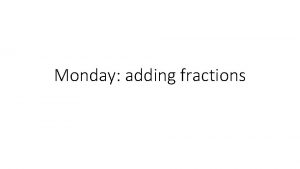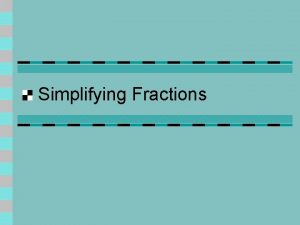Fractions Third Grade Teachers Ms Emily Ms Attina





























- Slides: 29

Fractions Third Grade Teachers (Ms. Emily, Ms. Attina, Ms. Kelly, Ms. Julia, Ms. Stern)

Grade 3 Fractions (3. NF. 3) • Explain equivalence of fractions in special cases, and compare fractions by reasoning about their size. • Understand two fractions as equivalent (equal) if they are the same size, or the same point on a number line. • Recognize and generate simple equivalent fractions, e. g. , 1/2 = 2/4, 4/6 = 2/3. Explain why the fractions are equivalent, e. g. , by using a visual fraction model. • Express whole numbers as fractions, and recognize fractions that are equivalent to whole numbers. Examples: Express 3 in the form 3 = 3/1; recognize that 6/1 = 6; locate 4/4 and 1 at the same point of a number line diagram. • Compare two fractions with the same numerator or the same denominator by reasoning about their size. Recognize that comparisons are valid only when the two fractions refer to the same whole. Record the results of comparisons with the symbols >, =, or <, and justify the conclusions, e. g. , by using a visual fraction model.

Naming a Fraction A fraction names part of a whole. The top number of a fraction is called the numerator and the bottom part is called the denominator.

Name the fraction



Comparing Fractions by looking at the numerator and denominator. If the numerator are the same… If the denominator are the same… Look at the denominator, the smaller the denominator, the greater the fraction. Look at the numerator, the greater the fraction.


If the denominators are the same, the greater the numerator, the greater the fraction

If the numerator are the same, the smaller the denominator, the greater the fraction

Sample Test Questions


If you could have half of either cookie, which half would you choose and why?

How to Recognize and Generate Simple Equivalent fractions ***** Explain why the fractions are equivalent, e. g. , by using a visual fraction model. e. g. , 1/2 = 2/4, 4/6 = 2/3



Sample Text Questions for Equivalent Fractions A⅛ B¼ C 2/4 D 4/8


Sample Test Questions for Equivalent Fractions

Possible Answer If the wholes are the same size and you shade half of each whole, then they are equal. ½ is equal to 3/6 and 2/4.

Mathematicians are able to understand a fraction as a number on the number line.

Mathematicians are able to understand a fraction as a number on the number line.

Mathematicians can represent any fraction on a numberline

Mathematicians can represent any fraction on a numberline

Mathematicians can represent any fraction on a numberline

Mathematicians can represent any fraction on a numberline



 Kim kroll
Kim kroll Gj mount classification
Gj mount classification Gj mount classification of dental caries
Gj mount classification of dental caries Pizza fraction word problems
Pizza fraction word problems Fractions assessment grade 4
Fractions assessment grade 4 Multiple meaning words lesson plan
Multiple meaning words lesson plan Third grade trivia
Third grade trivia Number sentence
Number sentence Welcome back hope you had a great vacation
Welcome back hope you had a great vacation Map skills third grade
Map skills third grade Doctor, lawyer, indian chief jump rope
Doctor, lawyer, indian chief jump rope What is the white part of an egg called
What is the white part of an egg called Grades of milk
Grades of milk Initial grade and transmuted grade
Initial grade and transmuted grade Low grade and high grade metamorphic rocks
Low grade and high grade metamorphic rocks Grading of grapes
Grading of grapes Emily dickinson i dwell in possibility analysis
Emily dickinson i dwell in possibility analysis Emily eyre
Emily eyre Emily carr woodbridge
Emily carr woodbridge Transcendentalism walt whitman
Transcendentalism walt whitman Walt whitman modernism
Walt whitman modernism Emily critchfield
Emily critchfield Emily davison
Emily davison Emeli sandé
Emeli sandé Jessie emily schofield poem and on aging comparison
Jessie emily schofield poem and on aging comparison Emily elizabeth forum
Emily elizabeth forum A rose for emily movie
A rose for emily movie Narrative ethnography
Narrative ethnography Direct and reported speech worksheet
Direct and reported speech worksheet Derek taylor husch blackwell
Derek taylor husch blackwell



